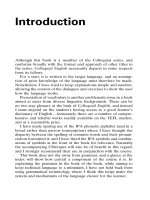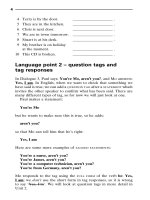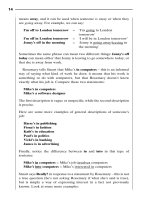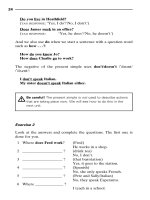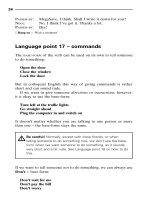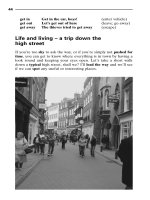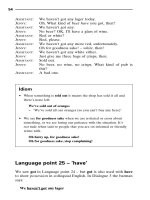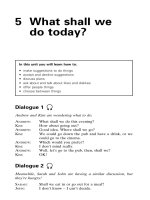Complete english punctuation rules
Bạn đang xem bản rút gọn của tài liệu. Xem và tải ngay bản đầy đủ của tài liệu tại đây (2.06 MB, 239 trang )
The Farlex Grammar Book
Volume II
Complete English Punctuation Rules
Perfect Your Punctuation and Instantly Improve Your Writing
Explore more books by Farlex at
FARLEX INTERNATIONAL
FARLEX INTERNATIONAL LIMITED
a Farlex Group Company
• USA • Ireland
farlex.com farlex.ie
Copyright © 2017 by Farlex International
All rights reserved.
Farlex supports copyright. Copyright drives creativity and creates diverse and vibrant culture. Thank you
for purchasing an authorized copy of this book and for complying with copyright laws by not reproducing
or distributing any part of this work without permission.
ISBN-10: 1537513907
ISBN-13: 978-1537513904
About the publisher
Farlex is the publishing team behind TheFreeDictionary.com, the award-winning
reference destination with 1 billion+ annual visits.
The most comprehensive reference resource online, The Free Dictionary is a
massive, easily searchable collection of dictionaries and encyclopedias from the
most trusted publishers, including McGraw-Hill, Houghton Mifflin,
HarperCollins, and many more.
Since its founding in 2003, TheFreeDictionary.com has grown to include a vast
and diverse amount of reference content, including multiple thesaurus sources
and specialty dictionaries covering fields such as science, medicine, law, finance,
idioms and slang, acronyms, computing, and more, as well as dictionaries in 14
other languages. Farlex dictionary apps powered by The Free Dictionary have
been downloaded tens of millions of times across multiple platforms, with top
ratings after hundreds of thousands of user reviews.
With the three volumes of The Farlex Grammar Book (Complete English
Grammar Rules, Complete English Punctuation Rules, and Complete English
Spelling and Pronunciation Rules), Farlex brings its reputation for the most
comprehensive, trusted, and easy-to-use reference products in the world to the
most thorough English language guides available.
Complete English Punctuation Rules offers its readers unprecedented online
integration. Every punctuation quiz in the book can be accessed for free at
TheGrammarBook.com.
For more books from Farlex, visit our Amazon page.
Preface
Punctuation is essential to learning how to write. Only when we master
punctuation can we begin to perfect our writing. More than a dozen unique
punctuation marks are used in modern English, and each mark can change the
structure and meaning of our chosen words in both drastic and subtle ways.
When we speak, we control this meaning by pausing or changing the inflection
of our voice; when we write, however, the only way to convey this meaning is
through the correct use of punctuation marks.
This guide covers all the ways punctuation shapes the English language as it is
written today. Because of how varied the usage of punctuation marks can be, it’s
crucial to understand exactly how each mark can (or cannot) be used.
Each chapter in this guide focuses on a different punctuation mark, providing
clear examples that show not only how to use it correctly, but how to identify
and avoid common mistakes as well. Since many punctuation marks overlap
with one another in how they are used, this book contains many cross-references
to make it clear when and why one mark might be preferable over another.
Once you have mastered the basic rules of punctuation, your writing will
become much clearer, better structured, and more precise. You’ll be able to add
more nuance and variety to your writing without worrying about whether you’re
using the correct punctuation. With this guide, you will have no doubt.
Editor’s Note
This book is written according to the standard styles and spellings used in
American English. While major differences between American and British
English are usually addressed, some information in the book might not coincide
with the styles, tendencies, or preferences of other English-speaking
communities.
Table of Contents
About the publisher
Preface
Editor’s Note
English Punctuation
Periods
Exclamation Points
Question Marks
Commas
Semicolons
Colons
Hyphens
Dashes
Slashes
Apostrophes
Parentheses
Brackets
Quotation Marks
Ellipses
Other Signs and Symbols
Quiz answers
Index
Thank You
More from Farlex
English Punctuation
Punctuation refers to the specific markings, signs and symbols that are used in
and around sentences to give them structure and to allow for correct
understanding and comprehension.
Providing structure
If we think of words as bricks that build a sentence (arranged in a certain pattern
according to English grammar), punctuation could be thought of as the mortar
that holds the bricks together. Without punctuation, our writing would just be a
continuous stream of words that lacked structure, pacing, and, ultimately,
meaning. For instance, let’s see how this same paragraph would look without
any punctuation:
if we think of words as bricks that build a sentence arranged in a certain
pattern according to English grammar punctuation could be thought of as
the mortar that holds the bricks together without punctuation our writing
would just be a continuous stream of words that lacked structure pacing
and ultimately meaning for instance lets see how this same paragraph
would look without any punctuation
While it’s possible to discern some of the meaning, it becomes remarkably
difficult to understand what is being said when no punctuation marks are used.
Providing internal meaning
In addition to providing overall structure and clarity to sentences, punctuation
can also provide nuanced internal meaning as well; that is, sentences that have
the exact same words can have different meanings depending on which
punctuation is used (or misused). Let’s look at some sets of examples that
illustrate this idea:
“Brackets are also used to distinguish parenthetical information that appears
within a larger set of parentheses. (Informally, though, it is quite common to
simply use a second set of parentheses.)”
“Brackets are also used to distinguish parenthetical information that appears
within a larger set of parentheses. (Informally, though; it is quite common
to simply use a second set of parentheses.)”
Here, by changing the second comma after though to a semicolon, we’ve
changed what informally refers to: In the first example, it is referring to the use
of a second set of parentheses as being informal; in the second example, it is the
use of brackets that is now being described as informal.
Now let’s look at two examples involving more complex punctuation changes:
“If we look at our sales team’s report, an increase in consumer confidence,
an upturn for our July figures, and successful budget cuts indicate a very
promising second half of the year.”
“If we look at our sales, teams report an increase in consumer confidence—
an upturn for our July figures—and successful budget cuts indicate a very
promising second half of the year.”
The second sentence’s meaning is now different from that of the first in three
ways:
1) By placing a comma after sales and removing the apostrophe from
team’s, the information is no longer a part of the sales team’s report.
Instead, teams becomes the subject of the verb report, of which an increase
in consumer confidence is the direct object.
2) By placing em dashes around an upturn for our July figures, it changes
the information from being part of a list to instead describing an increase in
consumer confidence.
3) Finally, because of these changes, successful budget cuts is now not a
part of a list of information but has rather become another subject: the
agent of indicate a very promising second half of the year.
By understanding the various nuances of how punctuation functions in a
sentence, we can be much more precise in the meaning we want our writing to
convey.
Minor mistakes with humorous results
Sometimes, misplacement or omission of punctuation yields silly,
humorous, or absurd sentences. For instance:
✔ “Attention employees: dangerous when active.” (With the correct
colon placement, this is a clear warning to employees.)
✖ “Attention: employees dangerous when active.” (Without correct colon
placement, this seems to be a warning about employees.)
✔ “Symptoms include inability to eat, feelings of paranoia, and
irritability.” (With commas, the individual symptoms are easy to
understand.)
✖ “Symptoms include inability to eat feelings of paranoia and
irritability.” (Without commas, it sounds like one of the symptoms is being
unable to eat certain feelings.)
✔ “OK, let’s start moving, Jack!” (With the second comma, it’s clear that
Jack is being addressed by the speaker and asked or invited to begin
moving.)
✖ “OK, let’s start moving Jack!” (Without the second comma, it seems
like the speaker is suggesting that Jack be physically moved by others.)
While the intended meaning of such sentences will probably still be
understood by the reader, it undermines the credibility of the writer to have
sentences whose literal meanings are so starkly (and humorously) different,
so it’s important to know where, when, and how to use the appropriate
types of punctuation.
Types of Punctuation
There are 15 unique punctuation marks that are used in everyday written
English. We’ve categorized them together according to the similarity of their
function. We’ll briefly look at each one along with some examples, but you can
continue on to their individual sections to learn more about the various ways
they are used.
Terminal points
Terminal points are those that mark the end of a complete sentence. These
include periods, exclamation points, and question marks.
Periods (Full Stops)
Periods ( . ), also known as full stops (especially in British English), mark the
end of sentences that are not questions or exclamations. For example:
“I need to buy new glasses.”
“She didn’t really like the play.”
“Reports are indicating increased activity in the region.”
“If I were able to live anywhere in the world, I would move to Beijing.”
“Please don’t be angry with him for what he said.”
Periods are also used to mark abbreviations, and they function as a decimal point
in non-whole numbers. For instance:
“Let’s find an A.T.M. [automated teller machine] so I can withdraw some
cash.”
“Your appt. [appointment] has been rescheduled for next Tuesday.”
“At current market value, the dollar is worth 0.89901 euros.”
Exclamation Points
An exclamation point or exclamation mark ( ! ) is commonly used to express
strong, intense emotions in declarations or to add emphasis to interjections and
commands.
For example:
“I can’t wait to travel to Paris next week!”
“I can’t believe I got into law school!”
“Yuck! I hate coconuts!”
“That was an impressive victory! Congratulations!”
“Please don’t stay out too late tonight!”
“Get out of here, now!”
“Go to your room this instant!”
Question Marks
Question marks ( ? ) are used, quite simply, to ask questions.
While it is usually a matter of intent and preference whether to use a period or an
exclamation point in declarative, conditional, or imperative sentences, we must
use question marks in interrogative sentences (sentences that ask questions); to
use any other terminal point would turn a question into a statement.
Here are some examples:
“How are you feeling?”
“You can’t be serious, can you?”
“It really ended just like that?”
“How? When?”
Pauses or breaks
Marks that indicate a pause or break in the flow of the sentence include
commas, semicolons, and colons.
Commas
Commas ( , ) are primarily used to join two or more elements in a sentence—
such as clauses, introductory elements, or items in a list—or to set parenthetical
information apart from the rest of the sentence.
For example:
“We can go to the movies tonight, or we can just stay home.”
“We have always wanted to buy a boat, sell everything, and set sail.”
“Either Tom, Bill, Jen, or Michelle will lead the seminar.”
“In a way, they are both right.”
“When I was traveling in Croatia, I met a lot of interesting people.”
“The office, an old colonial building, badly needed repairs.”
“The mirror, which was a gift from my grandmother, was broken during the
storm.”
“Find me something to dig with, such as a shovel or spade, so I can plant
these flowers.”
We also use commas for several technical purposes, such as listing a state or
country after a city, writing the full date, writing long numbers, or separating
quoted sentences from non-quoted text:
“I’m from Portland, Oregon, but I’ve lived in Washington, D.C., for more
than 10 years.”
“I first arrived in Europe on September 6, 2010.”
“There are over 15,000 protestors gathered outside Capitol Hill.”
“You should,” said my doctor, “begin feeling better immediately.”
Semicolons
Semicolons ( ; ) function like more powerful commas that create a stronger
break in the sentence. They are used to join lists when the items are complex and
contain internal punctuation, as well as to join independent clauses without the
need of a coordinating conjunction (though they are used with conjunctive
adverbs). For example:
“All I’m taking on the road trip is my truck, along with its spare tire; a
radio, which only kind of works; and my dog.”
“Jen hadn’t enjoyed the play; as a result, she didn’t recommend it to her
friend.”
“I hope the traffic isn’t too bad; I don’t want to be late for the movie.”
Colons
Colons ( : ) are used to add information that helps illustrate or clarify. A colon is
most commonly used to introduce a list, but it can also introduce quotations and
information that completes the meaning of the previous clause. Conventionally, a
colon can only be used after text that can stand independently as a complete
sentence.
Here are some examples:
“There are a few things you’ll need for the trip: a flashlight, a good
compass, a water purifying kit, clean clothes for seven days, comfortable
hiking shoes, and a heavy-duty rucksack.”
“If there’s anything I’ve learned from working here, it’s this: you don’t get
ahead in this industry by doing the bare minimum.”
“My father had a phrase he was fond of repeating: ‘Hope for the best, but
prepare for the worst.’”
Parenthetical information
We can insert text that has no grammatical bearing on a sentence by using the
two parenthetical markers: parentheses and brackets.
Parentheses
Parentheses ( ( ) ), sometimes called round brackets, are used to separate
parenthetical information that has no grammatical bearing on the structure of the
overall sentence. This can be a clause, phrase, word, or even just a punctuation
mark. For example:
“As I have said before (on numerous occasions), we must find a long-term
solution to this problem.”
“The goal by Hendrickson (and what a goal!) secured the team’s entry into
the championship finals.”
“She said I had behaved ‘like a yak’ (?) as she was leaving.”
“The last time I went to Toronto, I had an awful experience. (I won’t be
visiting again any time soon!)”
Brackets
Brackets ( [ ] ), sometimes called square brackets, function similarly to
parentheses but are only used within quoted text, indicating clarifying or
explanatory information that has been added to the quotation by the author:
“She [the governor] insisted that the restructured budget would not result
in funding shortfalls for schools.”
“The acting president has confirmed that ‘[t]he U.N. will ultimately have
oversight over reunification.’”
“In his analysis of the play, Thompson claims that ‘the entire second act
serves to underscore the persistence of hope that is always present in our
subconscious mind’ [emphasis added].”
Brackets are also used to distinguish parenthetical information that appears
within another set of parentheses. (Informally, though, it is quite common to
simply use a second set of parentheses.) For example:
“At least I’ll have some extra spending money this summer. (My cousin got
me a job at my uncle’s [his dad’s] warehouse.)”
Connectors and dividers
When we want to demonstrate a specific relationship between different letters,
words, phrases, or clauses, we variously use hyphens, dashes, slashes, and
apostrophes.
Hyphens
Hyphens ( - ) are most often used to join two or more words and/or affixes to
form a single and unique compound word. For example:
“Do you have any sugar-free cookies?”
“It is the only 10-storey building in the town.”
“My old-fashioned aunt would never approve.”
“I don’t mean to second-guess you, but you should check the work again.”
“This behavior is decidedly un-American.”
There are also several technical uses for the hyphens, such as when creating
divisions in sequences of numbers or expressing ranges.
Dashes
There are two types of dashes: the en dash ( – ) and the em dash ( — ).
En dashes are the preferred punctuation mark (especially in publishing) to
express ranges, scores, voting results, or connections between two people or
things (although hyphens are very commonly used instead). For instance:
“We need you to submit your expense report for January–March.”
“I’ll be in the office 8:00 AM–4:00 PM this Friday.”
“The board voted 5–4 to accept the proposal.”
“We will begin boarding the Denver–Chicago flight shortly.”
“The Republican–Democrat divide on the issue has only widened in
recent months.”
Em dashes, the longest of the dash marks, are most often used in place of
commas or parentheses to give greater emphasis to parenthetical information.
They can also informally stand in for colons when introducing a list or
illustrative information. For example:
“Many fundamental aspects of living on one’s own—cooking, cleaning,
doing laundry—are things for which many young adults are completely
unprepared.”
“The committee—which I have helped set up—will investigate spending
irregularities by CEOs of charities and other not-for-profit groups.”
“There are only two things I want to do on my vacation—sit on the beach
and read books.”
“Remember—keep your friends close, and enemies even closer.”
Em dashes can also be used to represent omitted or censored words, as well as to
indicate an interruption in written dialogue:
“Countess M——, a prominent member of the aristocracy, was in fact a
leading contributor to the resistance.”
“You ———!” he shouted. “I’m going to make sure everyone knows the
truth!”
“I don’t think this is a— ” he started to say when the branch suddenly
broke.
Slashes
Slashes ( / ) work in a similar way to hyphens, combining words and letters into
compounds. The slash is generally considered an informal punctuation mark, as
it provides a shorthand way of expressing connections between words. For
example:
“Each candidate must be sure to provide his/her [his or her] references
before the interview.”
“Whoever is leading the group study, he/she [he or she] needs to keep
detailed notes about how the time is spent.”
“We’ll need a signed statement from you and/or your employer [one, the
other, or both].”
“Rent is $650/month [$650 per month], due on the first day of each
month.”
“This singer/songwriter’s [singer who is also a songwriter] work never
fails to impress.”
Slashes are also used to form abbreviations in very informal writing, as in quick
notes or messages. For instance:
“Use hyphens b/w [between] compounds.”
“Our shop has been open 24/7 [24 hours a day, seven days a week] since we
first started up 30 years ago.”
“Will be late b/c [because] of traffic.”
In formal writing, such as academic papers, slashes are used to show line breaks
in poetry quotations. Conventionally, this is the only time when spaces are used
around a slash. For example:
“I’d like to include the following lines from Shakespeare’s ‘Sonnet 116’ in
our wedding ceremony: ‘Love is not love / Which alters when it alteration
finds, / Or bends with the remover to remove: / O, no! it is an ever-fixed
mark, / That looks on tempests and is never shaken.’”
Apostrophes
The apostrophe ( ’ ) is used to form contractions (two words shortened and
merged into one) as well as to show possession.
When used in contractions, the apostrophe replaces the letters that are omitted
from one of the two words. For instance:
“This plan doesn’t [does not] make any sense.”
“It’s [it is] a very unfortunate circumstance.”
“I hope you’re [you are] happy in your new job.”
“Please don’t [do not] do anything you aren’t [are not] sure about.”
When showing possession, the apostrophe comes before the letter “s” for
singular nouns (and irregular plurals) or after the letter “s” in regular plural
nouns:
“We were looking everywhere for Jonathan’s bike!”
“The kids’ play room is a mess.”
“We could stay in my family’s cabin for the weekend.”
“Police are gathering witnesses’ testimonies regarding the incident.”
“We’ll have to rely on people’s donations to stay open.”
Quoted material
When we quote something that someone else has written or said, we distinguish
it from our own writing through the use of quotation marks. If we omit (leave
out) any portion of a quote but keep the rest of it in its original form, we can use
ellipses to show where the omission exists within the quote.
Quotation Marks
Whenever we reproduce exactly what someone else has said, whether it’s a
word, phrase, or entire sentence, we use quotation marks—either double ( “ ” )
or single ( ‘ ’ )—to separate it from the rest of our writing. For instance:
John said, “I’ll never live in this city again.”
The CEO has expressed his ‘genuine concern and remorse’ over the
developments.
If we use a quotation that already has a quotation within it, we alternate between
double and single marks:
The president said, “I’ve been assured by the prime minister that she is
‘taking all appropriate steps in response to the crisis.’”
We can also use quotation marks to highlight text that is or might be considered
somehow questionable, dubious, or uncertain, as in:
His “promise” turned out to be a complete lie.
Quotation marks also have the technical use of marking the titles of smaller
pieces of written or creative works, such as poems or songs:
My favorite song has always been “Auld Lang Syne.”
Ellipses
An ellipsis (plural: ellipses) is a series of three dots ( . . . ) that represents
material that has been omitted from a quotation for the sake of neatness and
brevity. In general, this is only done when an omission is made in the middle of a
quoted sentence; any other punctuation necessary for the structure of the
sentence must be kept intact. For example:
“In response to the outcome of the trial, the president said, ‘I don’t think the
decision today reflects the . . . opinion of most Americans.’”
“The final passage sums up the protagonist’s view: ‘I’m sure of one thing in
life: I value family over all other things, . . . and I will never forget it
again.’”
“Our local correspondent told us that ‘[a]dvocates from around the state are
rallying around a new law aimed at reducing the number of roadside
accidents. . . . Still, there are some critics . . . who feel the law will have a
greater and more negative impact on commuters.’”
Less formally, ellipses are commonly used to indicate when a statement trails off
or is broken up due to uncertainty or hesitation, as in:
“I sure hope this works. . .”
“But. . . I don’t understand. . .”
Other Signs and Symbols
In addition to the 15 punctuation marks above, there are many different signs
and symbols that are commonly used in everyday writing, such as the asterisk
(*) or the ampersand (&). These are not standard punctuation marks—they are
never necessary to the grammatical or syntactic meaning of a sentence—but they
appear often enough that it’s important to know how they might be used.
Continue on to the section Other Signs and Symbols to learn more about them.

